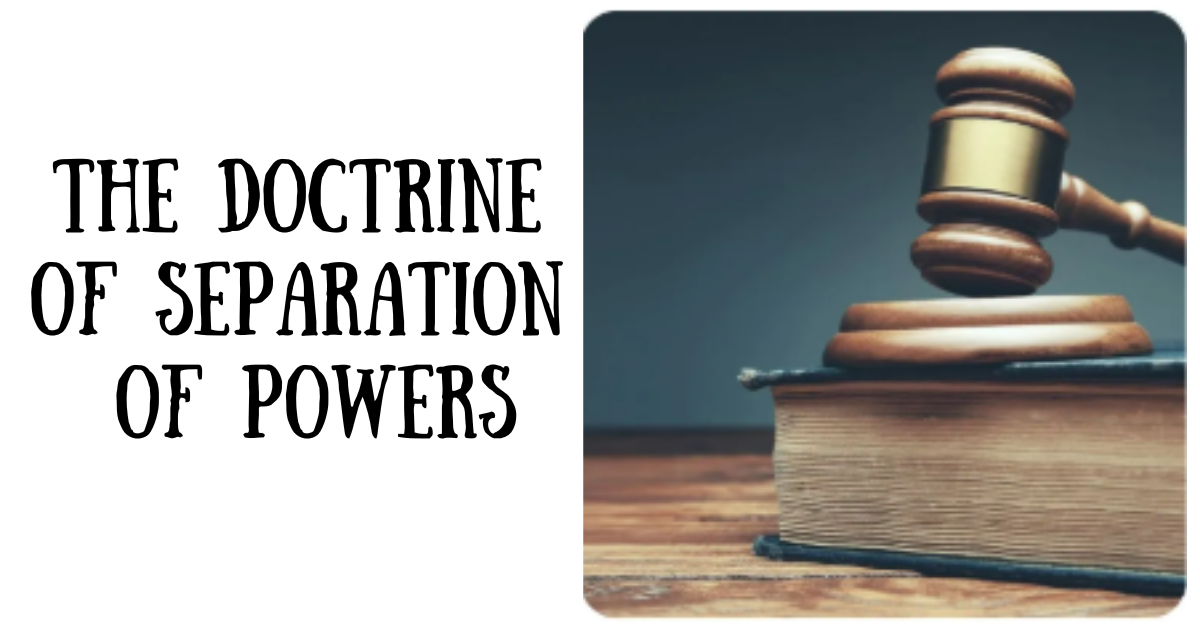The concept of the Doctrine of Separation of Powers is one of the fundamental pillars of democratic governance. It is based on the idea that the powers of government should be divided into three distinct branches: the Legislature, the Executive, and the Judiciary. This separation ensures that no single branch becomes too powerful, and each branch serves as a check on the others, preserving the balance of power. In this blog, we will discuss the Doctrine of Separation of Powers in the context of India, its relevance, and its implementation in the Indian constitutional framework.
What is the Doctrine of Separation of Powers?
The Doctrine of Separation of Powers suggests that the government should be divided into three branches, each with its own distinct powers and responsibilities. These branches are:
- Legislature: The branch responsible for making laws (e.g., Parliament in India).
- Executive: The branch responsible for implementing and enforcing laws (e.g., the President, Prime Minister, and Council of Ministers in India).
- Judiciary: The branch responsible for interpreting laws and ensuring justice (e.g., the Supreme Court and High Courts in India).
The idea is that each branch should function independently and without interference from the others. By creating this system of checks and balances, the doctrine prevents any one branch from accumulating excessive power and ensures that government power is exercised responsibly and within constitutional boundaries.
Historical Background of Separation of Powers in India
The Doctrine of Separation of Powers has its origins in the works of philosophers such as Montesquieu, who outlined the idea in his book “The Spirit of the Laws” in the 18th century. Montesquieu argued that the separation of powers was essential to prevent tyranny and safeguard individual freedoms.
India’s Constitution, adopted in 1950, enshrined the principle of the separation of powers to some extent, although it does not explicitly mention the term. The framers of the Indian Constitution borrowed heavily from the British system of parliamentary democracy and the U.S. Constitution, which had a clear division of powers. However, India’s system of governance is not a strict separation of powers as seen in the U.S. Instead, India follows a system of checks and balances, where the three branches are separate but interdependent.
Constitutional Provisions Related to Separation of Powers
The Constitution of India does not explicitly mention the Doctrine of Separation of Powers, but the principle is implicit in the distribution of powers outlined in various parts of the Constitution. Key provisions that relate to the doctrine include:
- Article 50 (Separation of Judiciary from Executive): This article mandates that the judiciary must be independent of the executive branch to maintain impartiality and fairness in judicial proceedings.
- Articles 122 and 212 (Parliamentary Privileges): These articles give the legislature certain privileges and powers to protect its functioning, thus ensuring that the legislative branch is free from executive interference.
- Article 356 (President’s Rule): This article allows the President to dissolve state governments under specific conditions, showcasing the executive’s power to control the functioning of the legislature in extraordinary circumstances.
- Article 141 (Judicial Precedents): This article empowers the judiciary to pronounce judgments that are binding on all courts, ensuring that judicial authority is separate from the legislative and executive branches.
Relevance of Separation of Powers in India
The Doctrine of Separation of Powers plays a vital role in maintaining the checks and balances within India’s democratic framework. Here are several key reasons why this doctrine is so relevant:
1. Prevention of Tyranny
The separation of powers ensures that no single branch of government can monopolize power. By dividing power among the legislature, executive, and judiciary, the Constitution prevents any one branch from becoming authoritarian. This safeguards the democratic structure and promotes individual rights and freedoms.
2. Checks and Balances
The system of checks and balances inherent in the separation of powers ensures that each branch of government has the ability to limit the powers of the other branches. For instance, the judiciary can review the laws passed by the legislature to ensure they comply with the Constitution, and the executive is held accountable by the legislature through mechanisms like parliamentary questioning.
3. Protecting Fundamental Rights
An independent judiciary plays a critical role in protecting fundamental rights. The judiciary in India has the authority to strike down laws that violate the Constitution or infringe on fundamental rights. This independence allows the courts to function without undue influence from the executive or legislature, thereby ensuring that citizens’ rights are upheld.
4. Promoting Efficiency in Governance
When each branch has a distinct role to play, governance becomes more efficient. The legislature focuses on law-making, the executive on implementing laws, and the judiciary on interpreting and adjudicating legal matters. This division allows each branch to specialize in its function and deliver results more effectively.
5. Preventing Conflict of Interest
If all functions of governance were concentrated in a single branch, there would be potential for conflicts of interest. The separation of powers ensures that the functions of governance are not compromised by competing interests within one branch.
Challenges to the Doctrine of Separation of Powers in India
While the doctrine is a cornerstone of India’s democratic setup, its practical implementation has faced challenges:
- Overlap of Functions: In India, the separation of powers is not as rigid as in the U.S. system. For example, the executive (the Council of Ministers) is part of the legislature, as the Prime Minister and other ministers are also members of Parliament. This overlap can sometimes blur the lines between the branches.
- Judicial Activism: The judiciary in India has been accused of overstepping its mandate on occasion, exercising powers that are traditionally considered the domain of the legislature or the executive. The judiciary’s active role in policy matters has sparked debates about whether the separation of powers is being maintained effectively.
- Executive Influence Over the Judiciary: Although the judiciary is constitutionally independent, there are concerns about the executive’s influence over judicial appointments, particularly through the collegium system. This can lead to questions about the impartiality and independence of the judiciary.
Conclusion
The Doctrine of Separation of Powers remains a vital component of India’s democratic framework. By dividing powers among the legislature, executive, and judiciary, it helps to ensure that no branch of government becomes too powerful. However, the implementation of this doctrine has not been without its challenges. The balance of power between the three branches must be continually monitored and adjusted to preserve the integrity of the Constitution and uphold democratic values. As India evolves, the relevance of the separation of powers will continue to shape its governance and safeguard the rights of its citizens.
In conclusion, the doctrine of separation of powers serves as a foundation for Indian democracy, ensuring that power is divided, checked, and balanced for the smooth functioning of governance. As the country faces new challenges, this principle will remain crucial in maintaining transparency, accountability, and the protection of fundamental rights.

